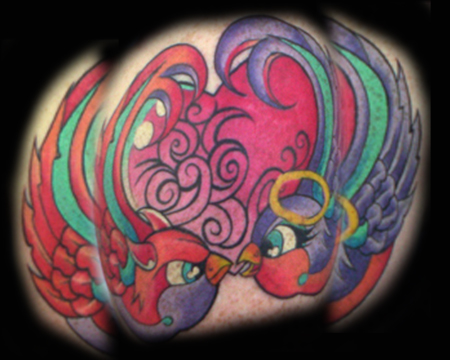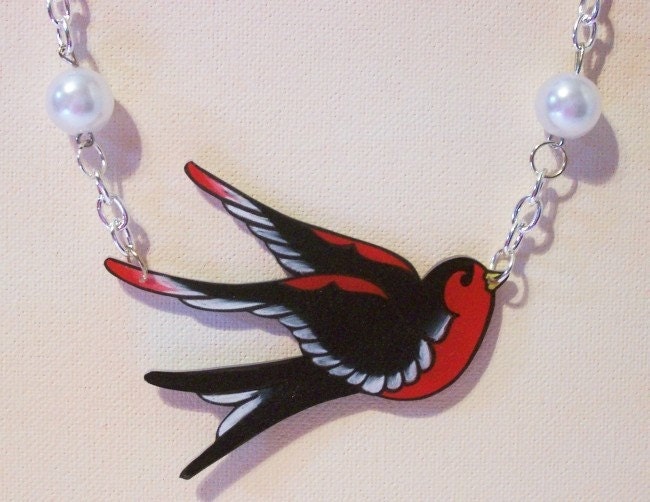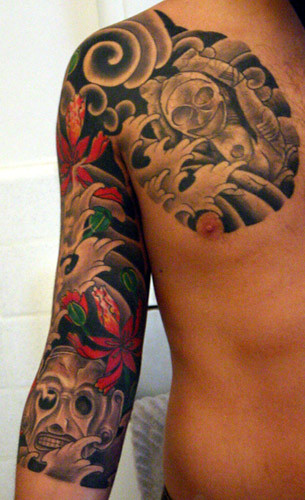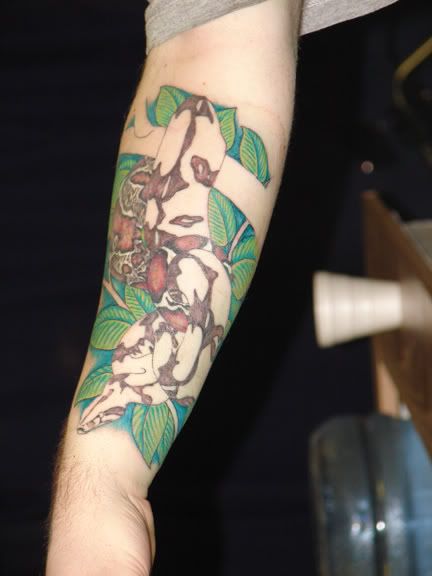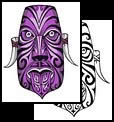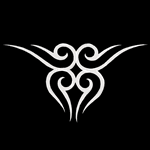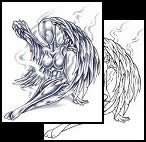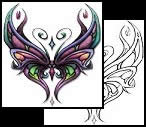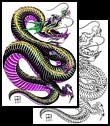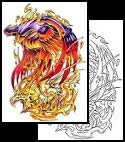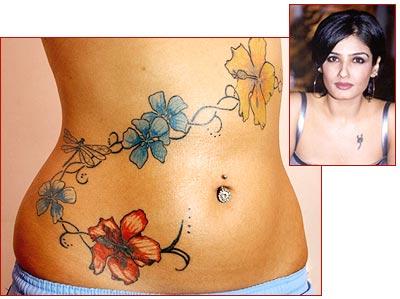



Tattooing as an art form has over the years been claimed by many countries tribal and ethnic groups. In many cases it is the same scenario of what came first - the chicken or the egg. We will probably never really know who were the first people to mark their skins.
We do know, and indeed there is much evidence, of this ancient and totally unique practice has been carried out since the beginning of time and body decoration is nothing new.
From scarification to body painting, piercing to the less permanent wearing of jewellery. Hair styles, even make-up, to the emergence in recent years of cosmetic surgery. People have always striven to change one’s appearance, and for millions of people throughout time, tattooing has been one of the most popular forms of permanent body art.
One country that probably has done more than almost any other, in securing tattooing’s place in history are the Islands of Great Britain. And as an Island race of people it is not surprising that Britain has such a tradition in this art form.
From royalty and the famous - to the common person, they have all stood shoulder to shoulder in enduring the pain, and the pleasure of becoming tattooed. In England there is a saying that horse riding is the sport of kings, and if that’s the case it is only fair in saying that tattooing is the art of the people.
Even the famed English naturalist Charles Robert Darwin (1809-1882), who not only upset religious groups and scientists throughout the civilised world with his thoughts on evolution, which appeared in his books the origin of species (1859) and the decent of man (1871).
His theories that man descended from lower animal forms caused great controversy, he also spoke of tattooing. Darwin’s scientific knowledge was gained when he served as a naturalist on the HMS Beagle in its surveys of the Pacific and Atlantic oceans during the years 1831 to 1836.
The Beagle did indeed land and explore many Islands in the Pacific regions and it was on the Beagles voyages that prompted Darwin to write about tattooing in his journal after meeting many natives with tattoo marks. He stated that there is no nation on earth that did not know of this phenomenon.
Charles Darwin went on to have a very varied and distinguished career and many papers were published of his life’s work. As for the upset he caused by his theories, it soon died down as he was honoured by many scientific societies throughout the world.
Darwin’s life ended on the 19th of April 1882 and possibly the greatest honour that could be bestowed on someone of his importance was that he was buried in Westminster Abbey on April the 26th of the same year.
For tattooing to be mentioned in such distinguished company made many people re-look at the art, many finding that they were standing at the dawn of a new era in indelible history.
But where did all begin for Britain, we know from documented evidence that the Board of the British Council of Churches in Calcutte, Northumberland, England, banned body markings. Claiming it to be a pagan practice, in 787 AD.
Little is really known of what type of markings were made prior to this. We know that Roman emperor Caesar wrote that all Briton’s stain their skins with woad and Herod of Antioch was truly amazed to find that Briton’s wear animals “incised” into their bodies.
We also know that the Pict’s of Scotland also painted their bodies in blue woad and in some cases some believe that they were also tattooed. Later it was thought that many of the Anglo-Saxon kings of England were tattooed, but much of this was conjecture as the first true fact of royalty being tattooed was King Harold II (1022-1066).
It was at the famous battle of Hastings where his tattoos were recorded for prosperity. Romantically the plight of Harold Godwinson of Wessex, the last Anglo-Saxon king of England and his sad demise has somewhat had the overtones of a romantic fable.
Rightly he died defending his country heroically, falling to a blow from the sword of a Norman knight and not the popular belief that he was killed by an arrow through the eye.
As for the tattooing it is also thought that Harold’s sister Edith picked out his mutilated body on the battle field by depicting the words Edith and England that were pricked (tattooed) on his chest.
King Harold’s remains were buried on the battle field and a memorial stone marks this, in the grounds of Battle Abbey. Later the King was reburied in Waltham Abbey. The confusion surrounding Harold’s death arises from the Bayeux tapestry which shows a soldier pulling an arrow from his eye and another warrior dying at the blade of a sword.
William of Poitiers who recorded the battle, noted that Harold was stripped of all regalia and could not be identified by his face, only by his body markings. Also it must be said that the battle of Hastings should have been called the battle of Senlac Ridge as this is where Harold fell on the 14th day of October 1066, eleven miles from the town of Hastings.
The next Englishman to establish tattoo links was Sir Martin Frobisher (1535-1595) who in 1576 set out on three unsuccessful voyages to find a north west passage to China.
Frobisher did find a certain amount of fame when he bought back to England an Eskimo women from one of his trips, who had chin and forehead tattoos. Frobisher went on to even greater achievements, when in 1586 he sailed as Vice-Admiral, in an expedition with Drake to the West Indies.
Two years later, Frobisher was given charge of a ship that helped defeat the Armada, and so distinguishing himself that he was knighted upon his own ship. Frobisher was later to die in battle from a fatal wound he received on the 14th of January 1595.
Meanwhile with the banning of tattooing by the church, it became an activity that almost died out. Going underground until the golden age of the pirate and explorers. So many tales and fables were being told of marked people in far off places, by seaman fascinating the people who were eager to listen.
In the journal of British settler, John Smith (1579-1631). He recorded of how he became a settler in Virginia, USA and of how he was captured by Indians and just as he was about to be put to death he was saved by a thirteen year old girl called Pocahontas.
Not only was Smith saved he was subsequently adopted by the tribe, and in his writings he told of how the Indian of Virginia, had legs, arms and their face’s decorated with black spots, presumably being tattoo marks. The name Pocahontas was thought to have been a romantic legend for many years, but she was a real person.
She was also a princess sometimes known as Matoaka the daughter of Powhattan the over King of the North American Indians at the time. Later she did marry a white man and he was John Rolfe. Pocahontas came with Rolfe to England in 1616 but died in less then a year of her arrival.
Not much is in evidence of tattooing in Britain in the forthcoming years and we had to wait until 1691 when the tales of William Dampier (1652-1715) became reality.
Historically Dampier was the first Englishman to set foot in Australia. Although he was not a great explorer and did not find anything that the Dutch had not found before him, he was somewhat of a colourful character and a noted buccaneer and great navigator. It was on one of his journeys to the South Seas where Dampier came across Scottish Explorer Alexander Selkirk, who was marooned on an uninhibited Island. This event was to later prompt Daniel Defoe’s famous book “Robinson Crusoe”.
William Dampier was born in Somerset, England and at an early age he wanted to see the world. At 18 he became a ships apprentice and did just that. Travelling the world three times, and after many adventures, Dampier returned to England on the 16th of September 1691, bringing with him the tattooed prince Giolo. Who soon became an instant attraction and crowds would come for miles around to see him, as Giolo was tattooed from head to toe.
It was said that one of his five wives did his tattoos, on his Island home of Meangis in the Philippines. He appeared at many carnivals throughout England, and Dampier was extremely happy with his new tattoo wonder. But alas it was not to last as Giolo became ill and died of smallpox in Oxford, England three months after arriving in Britain, 77 years before Cook set sail on his voyage of discovery.
And it’s that year we move onto, it was King George III of England, who on the recommendation of the Royal Society. Gave his blessings to an expedition to Tahiti to observe and record the transit of the planet Venus, which was due to pass between the earth and the sun on June the 3rd 1769. The Island of Tahiti in the South Pacific was chosen. For it was believed to be the best place the transit could be observed.
The royal society had the person who they wanted to lead the expedition and he was Alexander Dalrymple the renowned geographer and astronomer. But due to his lack of seafaring knowledge the Lords of the Admiralty would not consider him for the post, preferring instead to give the command to a 40 year old James Cook making him a lieutenant in the process.
The ship chosen for the voyage was formerly the Earl of Pembroke, a 368 ton vessel, which was a heavy but small ship. After a refit and a name change she became the Endeavour, and when she set sail from Plymouth, England, on the 19th of august 1768.
She had 94 men on board and provisions for 18 months. As it was decided by the admiralty that Cook would combine the observation of Venus with the voyage of discovery to the unknown Islands of the South Seas. And on the 11th of April 1769, King George Island (later known as Tahiti) was sighted.
Two days later Cook and a crew party stepped ashore for the first time. Little did Cook or the Admiralty back home in England know, that when they commissioned the voyage, they would unknowingly rekindle the art and passion of pricking (formerly the name for tattooing), and restarting the tradition of sailors the world over.
Contrary to popular belief it was not Cook who reintroduced the word tattoo (from the Polynesian word tattow) back into the English language, as a means of marking the skin. (The word tattoo has been with us in the English language since 1644, denoting the beat of a drum and a military term).
It was Joseph Banks (later Sir Joseph) who first recorded the name and customs of the people who wore the marks, and it was his observations that secured tattooing’s place back into British history. Through his journals Banks described the designs, the application and he also went into detail on how he was truly mystified why the people of Tahiti put themselves through so much pain. He also found that the body makings were performed on the natives between the ages 14 and 18.
Now with the transit of Venus having been observed, it was time for the Endeavour to set sail on possibly her greatest voyage. The date being the 13th of July 1769, and it was on this day that Cook told his crew of the secret orders of the Admiralty and that they were not to return home straight away.
So on the 7th of October the unexplored East Coast of New Zealand was reached. And two days later Cook went ashore with a party of men. A century before Dutch navigator Abel Janszoon Tasman (1603-1659), first sighted New Zealand. But Tasman’s expedition comprising of two ships the Heemskirk and the Zeehaen didn’t land of the newly found Island.
The natives who quickly surrounded the now anchored ships, seemed far to fierce, and indeed four men were killed when a boat from the Zeehaen dispatched to land on the Island, was rammed by the Maori’s. This shocked Tasman so much that he didn’t bother to try and land the Dutch flag on the Island, which he named Murderers Bay.
This also at first proved a problem for Cook and his men when they landed on New Zealand as four of the Islanders ran at them with long clubs, which prompted one of the crew to fire a shot over their heads. But this did not stop them and after a second and third shot killed one of the attackers, it made the others retreat.
The next day a Tahitian chief called Tupia, who had travelled from his home with the ship, approached the Maori’s who could understand his speech and persuaded them that Cook and his men meant no harm. But more trouble flared and three more of the Maori’s were killed. So with this Cook decided to turn north, and for the next six months he charted the coast and discovered that New Zealand was two Islands and not part of a larger land mass.
Also on this voyage were the men that in the days of no photography had the job of recording what had been seen via paintings and drawings. There were two artists on the trip, one being Alexander Buchan, the second Sydney Parkinson. Buchan was a landscape painter and his task was to paint the places which had been visited. But arguably Parkinson had the more important role in drawing wild life and specimens that were found.
Meanwhile Banks was busy writing in his journals, and he noted the tattoos of the people, and he wrote of the facial marks that seemed to have a channelled look. He also noted a broad spiral on the buttocks was quite common and that the women seemed to mark their lips black. Banks was most impressed with the Moko (facial tattoo) and how it gave the Maori a more frightening appearance, and although Banks thought the markings were ugly he admired the elegance of them.
Banks became so fascinated by what he had seen, and to go along with his scientific nature he found that he was to become the first Englishman to come into the ownership of a preserved Maori tattooed head on the 20th of January 1770. Hence starting the activity in the buying or trading of Mokoed heads from decapitated bodies. Banks picked the head from a batch of four that were brought to the ship Endeavour for the naturalist to inspect, and the head he chose was that of a young man of 14 to 15 years old. The other heads were not required.
During this time Sydney Parkinson did many drawings of the natives with tattoos, and he also made diagrams of the instruments that were used to tattoo the people. In his papers that were published in 1773 he went into great detail of the tattooing and probably more in depth than Banks' account, for Parkinson even had some tattoos put upon himself. So he did have a first hand knowledge of the art. Today Sydney Parkinson’s drawings can be seen at the British Museum London, England.
William Bligh (1754-1817) was Sailing Master on Cook’s second voyage to the Pacific sailing from Plymouth, England on July the 13th 1771, and on this trip Bligh did indeed make his name by discovering the Breadfruit, gaining the nickname Breadfruit Bligh.
It was also on this trip, that the commander of Cook’s second ship “Adventure.” Captain Tibias Furneaux, who on Cook’s orders, took back to England in 1774 the Polynesian Omai, who was placed into the care of the Earl of Sandwich, first Lord of the admiralty, and Joseph Banks who gave Omai lessons in the art of manners.
Soon Omai became the wonder of the age. He met royalty and many of England’s most fashionable citizens, he even became a frequent visitor to most of London’s theatres and was regarded as one of the capitals most exciting figures. It was also said that Omai was tattooed but not much is recorded of his body markings.
After much success Omai was to return home to the Island of Huaheine with Cook on the “Resolution” in 1776. William Bligh also sailed on Cook’s third and final voyage to the South Seas. It was on this ship in 1776, Cook recorded in his log, that he was amazed when he landed on the Sandwich Island (Lord Sandwich commissioned the expedition to the Island, later to be known as Hawaii).
The inhabitants were darker than the Tahitians but spoke in a similar language and were a handsome race with the men being variously tattooed. Now this was the last mention of tattooing in the official records of Cook. As it was on this trip (the third) on the 14th of February 1779, the brilliant career and life of James Cook ended, killed by the natives of Hawaii.
The surviving members of the two ships of Cooks last voyage the “Resolution” and “Discovery” returned to England, and it was the navigation skills of William Bligh on the “Resolution” that enabled the safe return of both ships. In official admiralty records it states that Bligh was indeed equal in terms of navigation and cartography.
But he was also a man of completely different character and he was said to have had an uncertain temperament and a sharp tongue and hated any form of inefficiency. Perhaps it was his at times rude and insensitive nature, that led men under his command to commit the sin of mutiny, and three times did Bligh suffer this in his career.
The second of the three mutinies was in 1797. Bligh’s ship the “Director” was taken from his command and he was put ashore by the officers of the vessel, and in the subsequent court proceedings that were to follow, Bligh was cleared of any wrong doings.
So in 1805, he was thought to be the right person to become governor of the convict colony of New South Wales in Australia. Little did he know at the time, that the scene was set for the third mutiny of his career. This was not to be on the high seas, for it was his tough administration on the convicts, and even the farmers and his own officers that led him to be hated. It was the banning of rum rations, that was considered to be currency at the time, which led to the famous rum rebellion ending Bligh’s 18 months as governor.
On the 9th of March 1809 Bligh was put upon the HMS Porpoise and returned to England. Now in terms of British history nothing was ever said of tattooing in these two events of his life, but he did mention tattooing on a number of occasions in his official log of possibly the ship many remember Bligh for, the Bounty.
First it must be said that although many thought Bligh was a difficult man, he also had many admirers. On his return of the last voyage of Cook, he found that his country needed him, for he was appointed master of a captured French frigate “The Belle Poule,” which Bligh took into action against the French and Spanish. Helping in the relief of Gibraltar, returning to England on the 14th of November 1782, with honour and distinction.
This was to be Bligh’s last engagement with the Royal Navy for five years. Bligh settled down with his wife and first daughter Harriet Marie at their home on Douglas, Isle of Man. It was his wife’s uncle, Duncan Campbell a merchant, but importantly for Bligh a ship owner at the time, persuaded him to return to his beloved sea, becoming commander of Campbell’s ships.
Later taking the post main agent to the port of Lucea for a number of months. With this now well paid job his duties were to bring ship loads of rum and sugar via the Atlantic. Bligh’s life was very happy and his wife gave birth to two more daughters. One of the ships Bligh was master of was the “Britannia” and it was on this, where Bligh first sailed with 21 year old Fletcher Christian and a great friendship was born.
It was not long for William Bligh to be recognised again for his great seafaring skills. The now Sir Joseph Banks was president of the royal society, and with a large financial interest in the West Indies and with his constant worries about providing cheap food for plantation workers. Banks remembered Bligh’s breadfruit, and it was needed to make the West Indies more self sufficient as at the time America’s War of Independence was making it very hard to bring imported food over from North America.
Early in 1787 discussions about the transport of breadfruit began. In May of that year the voyage to secure the plants was given the blessing of King George III. Bligh through Banks insistence was given the news of his newest command on August the 5th. Which for a 33 year old was a great honour indeed.
The vessel chosen by Banks for the trip was a merchant ship called the “Bethia”, but first she had to undergo great modifications and a large greenhouse had to be installed in the two year old ship. As it was the wish of Banks that 1,000 plants should be collected on the voyage.
At the end of September the “Bethia” was refitted and she underwent a name change becoming HMS Bounty. The Bounty’s mission was a trading one, Bligh set about securing, 2,800 knife blades, 1,000 knives with sheaves. Thousands of nails, screws, hatchets, mirrors, beads, and clothes, which Bligh knew the Polynesians loved and were worth a fortune in their local currency, but to Bligh the items he bought cost a mere £120 pounds in England.
All the crew of the Bounty, apart from gardener David Nelson and his assistant William Brown who were picked by Banks, were picked by Bligh personally for the two year journey. First on Bligh’s list was his new found friend Fletcher Christian who was 22 years old. All in all Bligh’s company consisted of 45 men, and his orders were to sail from England to Tahiti, some 12,000 miles, to collect the breadfruit plants and take them to the British West Indies.
So the Bounty left England on the 23rd of December 1787. But to Bligh’s horror he soon found that some of the men had left a lot to be desired. The ship’s surgeon James Huggan, was a drunk. Others were insubordinate, inexperienced and lazy for such a voyage, It was Bligh’s passion to sail around the Cape of Good Hope, that led to many mutterings of discontent from the crew, as it was now the wrong time of the year, and much too dangerous to attempt.
It has been said that this failure led Bligh’s criticising and abusive manner to his officers in front of the lower ranked members of the crew. This was all forgotten when the Bounty finally reached Tahiti. The men found the natives extremely friendly, as the Polynesians went out of their way for their new friends.
Bligh himself was said to have been treated like a King by them, and even when it was discovered that they had arrived too late to collect the bread fruit saplings and they would have to spend six months before the next harvest didn’t unduly worry Bligh. And instead of sending his men on exploratory trips, Bligh gave his men unlimited shore leave.
But the only thing this achieved was to make the men become sloppy and supplies were left to rot, nails and metal became rusty as the men spent more time with the native women, living a carefree life. It was during this time Bligh wrote in his log of the tattooing of many of the crew who were getting pictures of what the natives had been putting upon themselves.
So with what Bligh was seeing he ordered that the men returned to the Bounty and shore leave was cancelled. This did not please the men and three of them deserted only to be captured later by Bligh. Discipline was again maintained and after 27 weeks 1,015 plants were collected and the Bounty set sail for the Indies.
Things seemed to be going well until one night William Bligh accused Fletcher Christian of stealing a coconut, and after a very public row Christian returned to his cabin in anger. Later that night Christian asked two members of the crew to help him secure material so that he could make a raft and escape over the side, as the Bounty was still fairly close to the Island they had just left. And when midshipmen George Stewart told Christian that the men were ripe for anything, this sparked the famous mutiny on the Bounty.
On the morning of the 28th of April 1789 Bligh and 18 men were put into a boat with provisions and set adrift. Only one man was lost in the next 41 days it took for the open boat to reach the Dutch Island of Timor, and it is still regarded today as one of the greatest feats of navigation in British Naval history.
Upon Bligh’s return to England he was court marshalled for his loss of his ship but was honourably acquitted. At the court marshal Bligh read from his log and described the mutineers (which he called Pirates). He gave the men’s height, their ages, colour of eyes and all the tattoo marks they had acquired on Tahiti.
Bligh’s log went into great detail about the men’s tattoo’s. Of all the 25 who mutinied 21 were tattooed. Each and every one’s tattoos were carefully recorded by Bligh in his records. The official log of the Bounty is housed in the public records office in Kew, London, England. As for Bligh himself, after a long and eventful career he retired to live in a small village in Kent, England, dying a Rear Admiral in 1817.
Meanwhile back in New Zealand, not only did the white man bring with him, when he first started to live on the Islands many things that fascinated the Maori, he also brought disease and to coincide with the inter-tribal wars in the 1820s. It was feared that the Maori people would die out.
For histories sake, it was decided that the people and the customs of the Maori should be recorded and Major-General Horatio Robley became one such recorder. Robley himself saw battle at Gate Pa and Te Ranga. The major, who was only in New Zealand for two years drew many drawings and painted a number of paintings that depicted the Maori Moko which he did on the battlefields. Many of the works of the tattooed Maori’s became classic historical records of this period in time.
Upon retirement from the British army, Robley went on to publish one of the best books on Maori tattooing, called “Moko” in 1896. Today many of the items of Robley’s collection of tattooing and other Maori artefacts are housed in the British museum London. Also around this time in the mid 1880s, British Governor of New Zealand Sir George Grey had many Maori Moko’s copied by having facial masks cast of Maori chiefs, so that the people could see their tattooed marks easier.
Back in Britain the stories of Bligh’s plight with the HMS Bounty, and with the successes of Giolo and Omai, it was not uncommon for seafaring men to give up the sea to become tattoo exhibits at fairgrounds. Some even aroused curiosity in the medical profession, earning large sums of money. And not just men, as many women became tattooed icons, and a certain Miss Cary appeared at a London theatre describing how, as a child she was kidnapped and elaborately tattooed.
Another person who also claimed to have been unwillingly tattooed was John Rutherford who in 1827 arrived on the exhibition scene. His first appearance being in his home town of Bristol, England. His body had tribal marks on his arms and legs and torso, but more amazingly for the people of England he had the full Maori Moko on his face.
Rutherford would stand and tell how he was captured in 1816 by a tribe of New Zealand Maori’s and forcibly tattooed during a ritual. He also told tales of how it took up to six weeks at a time for his tattoo’s to heal and how he managed to escape and return to England. It was said that he made quite a tidy profit with the tales of his story.
Later in life Rutherford did admit that much of it was fabricated, but he insisted that the Maori Moko on his face was genuine and done in New Zealand.
Now with the tattoo attractions being displayed, tattooing took on a new significance with members of the British public. But it was not until 1862, when tattooing really took off in terms of popularity, for it was in that year the Prince of Wales, later becoming King Edward VII visited the holy land of Jerusalem.
Whilst he was there, and at the age of 18, he was tattooed by Francois Souwan, who tattooed the prince’s arm with a cross. In later years the prince was also tattooed by Britain’s Tom Riley and Sutherland Macdonald.
The prince of Wales, Edward became King of England upon the death of his mother Queen Victoria in 1901. Before this, other stories started to appear in the popular press and Britain’s law courts, and it was the strange case of Sir Roger Tichborne in 1872 that again brought tattooing into the forefront of public attention.
It was believed that the unfortunate Sir Roger was shipwrecked some twenty years previously and was lost in the great tragedy. So the reappearance after the twenty years of Sir Roger caused great concern for the family, as the man who reappeared tried to reclaim Tichborne house, the residence his family had owned for the last 800 years.
During the court case that followed tattoos did play an important part in proving that the man was a fraud, as it was when the friends of Sir Roger asked the man to show the many tattoos that the real Sir Roger had upon his body. He could not show such marks on himself.
The man turned out to be London butcher Arthur Orton, who for his trouble obtained a prison sentence for his deception. In the summing up of the case chief justice Cockburn called the tattoo evidence conclusive in the trial.
The case of Sir Roger Tichborne did stir the peoples imagination but not as much as when the two royal princes Prince Albert Victor and Prince George Frederick Earnest Albert, were reported to have been tattooed while serving in the royal navy on HMS Bacchante in 1879. The first story of the boys getting tattooed was when they visited the botanical gardens in Barbados, where they were encouraged to have a whiff of some large lilies which were on display.
By doing this, their face’s became covered with yellow pollen, and an enterprising young journalist telegraphed back to England, that the princes had their nose’s tattooed with anchors. Upon hearing of this the boy’s mother Princess Alexandria wrote on December 30th 1879. “How could you have your imprudent snout tattooed? What an object you must look and won’t everyone stare at the ridiculous boy with an anchor on his nose. Why on earth could you not put it somewhere else?”
This prompted the boy’s tutor, who was with them on the voyage John Neale Dolton, to reply back on January the 27th 1880. “I wish to set your Royal Highness’ mind at rest about the tattooing. The noses are without any flack marks, scratch or spot of any kind. The skin is as clear and white, as the day they left home.”
The boys did at a later date become tattooed, and its said that they were tattooed by Hori-Chyo of Yokohama Japan, on the third cruise of the HMS Bacchantes (which departed on the 14th of September 1880, returning to England on the 5th of August 1882).
On this, the boy’s last cruise, they visited the Holy Land and at Jerusalem the two princes got tattooed, and in an official letter to his mother, Prince George wrote “we have been tattooed by the same old man who tattooed papa, and the same thing too, five crosses. You ask Papa to show you his arm.” This was to be the recorded evidence of the princes to be tattooed in official records, and for the record Prince Albert Victor, who was affectionately known as prince Eddie, became the Duke of Clarence and Avondale in May 1890. Having two years earlier caused a royal scandal by becoming a suspect in the Jack the Ripper enquiry’s.
Albert who was first born was indeed in line for the throne of England, but he died in 1892, this putting George in line to succeed, and on the death of his father Edward VII in 1910 he became King of Great Britain. Ruling until his own death in 1936.
So with the stories of the two princes becoming tattooed, tattooing became in vogue for many people and it was not uncommon for the higher classes of British society to show their newly acquired body markings.
Arguably the most significant factor to the re-emergence of the ancient art of tattooing would have to be the electric tattoo machine. Overnight turning the long drawn out process of hand tattooing, into a relative, slick, clean almost painless procedure.
And we have to dive into the annuals of British history to find the significance of the first electric tattoo machine, which was invented by Irish American Samuel O’Riley and was patented at the United States Patent Office on December the 8th 1891.
The machine O’Riley invented, derived from the earlier autographic printing pen Thomas Alva Edison (1847-1931) had invented and patented on October the 29th 1875 in London, England, patent number 3762.
It is not known why Edison patented his device in Britain before his native America. He did receive the US patent for his machine in 1876. If O’ Rileys machine did resemble the Edison autographic pen. Then it can be said that the first British tattoo machine patent was that issued to Sutherland Macdonald.
Source : http://www.tattoo.co.uk/history.htm



